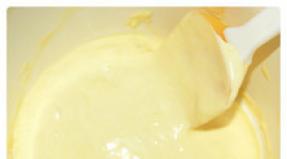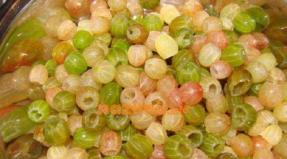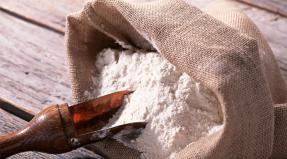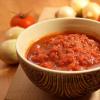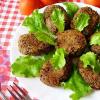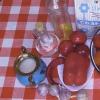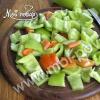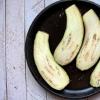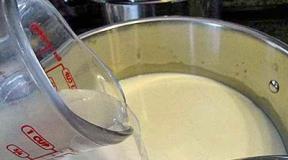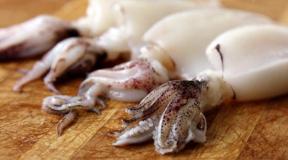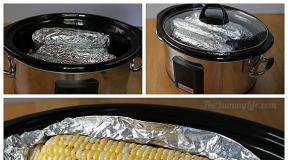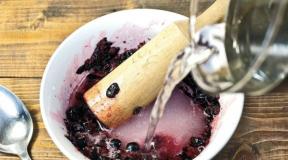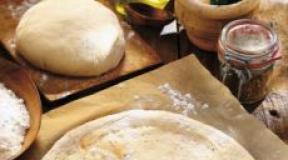What are the signs of the end of the fermentation of wine. violent fermentation
In winemaking there is no single technology used by all that will allow you to get a quality product. There are a large number of different recipes, a lot of nuances. Everyone who is fond of the independent process of making alcohol makes it using his own tricks. However, the main thing is the fermentation process, since it is he who determines the important characteristics of the wine.
Process features.
The main role belongs to yeast fungi. As a result of their activity, they process sucrose into carbon dioxide and alcohol. The quality of the finished drink will depend on at what temperature and for what period of time homemade wine roams. To prepare the base, grapes or other fruits or berries are taken, all raw materials are carefully sorted, rubbed or crushed, then placed in a suitable container, which is covered with gauze and placed in a dark place. So the mass stands for a limited number of hours before the first signs of fermentation appear. Then a glove is put on the container to monitor the formation of gas.
It is difficult to determine exactly how much good homemade wine should ferment. As a rule, the process lasts from 30 to 90 days. The time depends on the amount of sugar, the quality of the yeast and the temperature.
Fermentation of any type of wine at home is conventionally divided into 3 stages:
- elementary;
- stormy;
- quiet.
At the first stage, yeast fungi adapt to the new environment and begin to multiply actively.
At the second stage, the reproduction of bacteria ends, they occupy the entire volume of the wort, resulting in the release of alcohol. This period lasts from 10 to 100 days, depending on whether the drink should be strong in finished form. The longer the rapid fermentation goes on, the more alcohol will be in the liquid. The first few days, the mass foams heavily and hisses, there is an active production of carbon dioxide.
After the must calms down, the number of bubbles decreases. The foam formed at the beginning settles at the bottom of the tank, the process begins in the lower layers. The duration of this phase of the bottom fermentation of homemade wine lasts until the fungi turn all the sugar into alcohol. At this stage, few bubbles are released, a precipitate forms above it, the liquid brightens.
It is important to remember that the fermentation process must be actively maintained. To do this, you must follow some rules:
- Shake up the sediment. With a dense sediment, it becomes more difficult for yeast fungi to work. To help them, the liquid must be shaken. To do this, you can shake the vessel or stir the sediment with a clean wooden stick.
- Ventilate the must. If the fungus reproduces too slowly, it is recommended to give the wort access to oxygen, this will stimulate the work and reproduction of bacteria. You can pour the liquid into another vessel or simply leave it open for 3-4 hours. This should be done only in the bottom fermentation phase, when 6–7 ° alcohol is formed in the product.
- Add sugar. This may be needed for the fortress. Sugar is added fractionally. After each addition of a portion of sugar, the wort should be stirred with a clean wooden stick.
- Maintain the correct temperature. It is very important to ensure that the drink is kept at the same temperature. If it is too hot, the yeast will process the sugar too actively, which will worsen the quality and strength of the product. If it gets cold, the must will stop fermenting and spoil.
At the last stage, when the wort stops fermenting, almost all the sugar is processed into alcohol, the number of active yeast fungi decreases. At this stage, the taste of the drink is formed. It lasts from 50 to 350 days. The resulting product is poured into a clean container and stored in a dark, cool place (basement or cellar) at 10–15°C.
How long should house wine stand? White is kept for at least 1.5 months, red - from 2 to 3 months. Then it is poured into bottles, tightly closed with corks and stored at a temperature of 5-9 ° C in a supine position.
What to do when the wine has stopped fermenting
When the wort will ferment, it is important to follow all the rules. In order to monitor the maturation of the drink, a rubber glove is put on the container. When the yeast is actively multiplying and converting sugar into carbon dioxide, the glove inflates. This signals that the active phase of maturation is underway. However, even if all the recommendations for making a drink are followed, there is a possibility that the raw materials will not start or stop fermenting. What to do?
Why doesn't a rubber glove rise on fermenting house wine? There are a number of reasons why this happens and recommendations on how to avoid it.
- Not enough time has passed. After a water seal is installed, for example, a lid with a tube, the process does not start immediately, the activation of the yeast takes a couple of days. Maybe it's just not time yet.
- There is no sealing. There will be no bubbles in the liquid when the wort container is loosely closed. In this case, the glove will not rise. To remedy the situation, remove the foam from above and add a little sugar.
- Wrong conditions. The optimal mode is 15–25°C. At low temperatures, the yeast stops multiplying, and at high temperatures, it dies.
- Poor quality yeast. You can never be sure that the yeast is good, often they can stop working for no apparent reason. In this case, homemade sourdough, ready-made wine yeast or a few unwashed grapes are added to the must.
How long a quality homemade wine will ferment depends on how you follow the fermentation process and follow all the recommendations.
Features of the temperature regime for the fermentation of wine at home
The best maturation of the drink is slow. 15–25° are the best conditions for this process. Drops should not be allowed.
At what temperature does house wine ferment well? The optimal mode for white wines will be 14-18°C, red and rose - 18-22°C. The fermentation time of high-quality homemade wine also depends on this:
- 10–14° - 20 days;
- 15–18° - 10 days;
- 20° - 5–7 days.
In conclusion, experts advise paying attention to some of the nuances that will help make the “drink of the gods” a real source of pride.
- Carefully select raw materials, rotten berries and fruits should not be allowed to enter.
- The fruits must be sweet, ripe, so that the yeast actively processes sucrose into alcohol.
- Dishes must be dry and clean.
- During storage, it is recommended to pour the drink into another container every six months, decanting the sediment.
- You can not store the product near starters, vegetables, animals and birds, it very quickly absorbs odors and deteriorates.
Winemaking is a kind of science in which there are many nuances and subtleties.
Delicious wine can be made at home, but it will take some time. Usually this drink can be made from grapes, fruits and various berries. But many winemakers and wine lovers prefer grape wine.
Good wine is also good for health if consumed in moderation.
The most important moment in the process of making wine is considered fermentation, i.e. the natural process of converting grape juice directly into this drink.
Earlier, when winemaking was in its infancy, people made wine by simply squeezing grapes by hand. In general, the wine should form on its own, as the surface of the berries is replete with wild yeasts. Alcoholic fermentation is important for winemaking. Thanks to the action of yeast fungi, the sucrose contained in fruits is converted into carbon dioxide and alcohol.
Important! Before making a drink, the berries should not be washed, as they themselves contain a sufficient amount of wild yeast on their surface.
Today, experienced winemakers use yeast or sourdough.

One type of sourdough is raisin sourdough, which is considered the most affordable at home:
- Such a starter should be stored in a warm place before being added to the pulp - a wine material obtained from berries.
- The shelf life of the starter should not exceed 5 days.
- For reinsurance, winemakers sometimes add some quality raisins, which play the role of wild yeast in this case.
Another important factor affecting the fermentation time of the drink is the correct temperature regime.
Important! For a normal fermentation process, the temperature of the room in which containers with wine material will be stored should be 18-23 degrees.
If the temperature is higher, the quality of the drink will decrease, and it may turn into vinegar. If the temperature is below normal, then fermentation may not even begin. If the process of preparing this drink falls on the autumn period, then it is better to store it in a room that will be heated in the future.

It must be remembered that the resulting pulp must be placed in a container with a wide mouth, for example, a wooden barrel, a glass bottle, or an ordinary enameled pan.
Reference! Do not use copper or aluminum utensils, as the reaction of their interaction with the wort is unpredictable.
Fermentation is a rather capricious process, any omission, departure from the rules and non-compliance with these standards can lead to the loss of wine material or stop the process.
As mentioned above, the processing of sucrose produces gas and alcohol. But an increased amount of gas can lead to an explosion in the container, so it is sometimes necessary to open it and let the gas out.
At the same time, we should not forget that prolonged contact of the drink with oxygen can also lead to unpleasant consequences, for example, the appearance of mold or the souring of wine.
For such purposes, special shutters are installed on the container with the fermenting drink, and at home you can also use regular medical glove.

It can serve as an indicator of the ongoing process:
- For example, an inflated glove indicates that the fermentation process is active, and a deflated one indicates that there are problems in the process.
- Before installing the glove, you need to make several punctures with a needle in its upper parts.
- During fermentation, it is necessary to periodically check whether the glove has fallen off the neck.
What to do if fermentation stops?
Sometimes it happens that the fermentation process starts on its own, even if you just forget somewhere a bottle of fruit juice or fruit drink. But it also happens that the process does not go at all, even if enough time has passed.
In total, this process can take 30-90 days.
Reference! The duration depends on the amount of sugar, the quality of the yeast and the temperature.
Almost always, the reason for stopping the fermentation process is non-compliance with any rules for making wine, therefore, in the first place it is necessary to create optimal conditions for the yeast to work:
- To do this, you need to check the temperature conditions of the room and, if necessary, transfer the container to a room with a suitable temperature.
- You can also add some yeast to the pulp, as wild yeast may not always give the desired result.
Sometimes it happens that there is not enough sugar in the pulp. In this case, you can also add regular sugar and check its rate using a special device, its rate should be 10-20%. If there is too much sugar, then the pulp must be diluted with water.
What to do if homemade wine does not ferment is described in the video:
Rules of a competent winemaker
Competent winemakers with considerable experience in this field use their proven methods for harvesting, storing it and making delicious wine. For an experienced winemaker, not only the weather or the time of year during the harvest of berries, but even the time of day plays an important role.
Basic Rules:
- To obtain a sweet white wine, it is necessary to leave the berries on the bushes for as long as possible, but not to overdo it. To increase the sugar content in grapes, their crests are even twisted at the base.
- When picking berries, you need to make sure that you do not come across rotten ones, it will be better if they are ripe enough. The collection utensils must be dry and clean.
- After making the wine, it must be periodically poured into another container for decanting the sediment. The drink should not be stored near foods or animals that have a pungent odor, as wine tends to absorb their smell.
For different types of homemade drink
On average, any wine ferments from 20 to 45 days, and some - up to 70 days.

The duration of fermentation of different types of wine:
- Cherry wine has a tart taste and excellent aroma. It must be prepared from freshly picked berries, in extreme cases they can be stored in the refrigerator for no more than 3 days. When preparing this type of wine, sugar, alcohol and wine yeast are also required. In general, the fermentation process of cherry wine will be about 10-15 days. If you use the glove fermentation method, the fermentation process will take 3-4 weeks.
- Classic house wine from grapes may ferment longer than wine made from other berries. The process can even take several months. The time required to finish fermentation will depend on the sugar content of the grapes, the quality of the yeast and the temperature conditions in the room where the wine is made.
- For making wine currant berries, water and sugar are usually required. The process doesn't take long. For example, the fermentation process of such wine can last one week. Some recipes for making currant wine require several weeks of fermentation to produce a tart, characteristic drink.
How to make cherry wine at home and how much it should ferment is described in the video
Silent fermentation and care
The poured wine is not yet completely transparent. It contains some more yeast and negligible amounts of sugar that did not decompose during rapid fermentation. In addition, from contact with air during pouring, the protein substances dissolved in it begin to fall out of the wine until then, which should be removed from the wine, otherwise it may subsequently become cloudy forever and be fragile. All this happens during a quiet fermentation, also called the post-fermentation of wine. Fermentation usually ends after 7–10 weeks. In some cases, it lasts 3-4 months and usually ends by the spring of the year following the preparation of the wine.
Its ending is determined by taste. Fermented wine begins to lighten, sediment forms at the bottom of the bottle. 8–10 days after the end of fermentation, the clarified part is poured into a clean bottle with a hose, filled to the neck, and placed in a cool place.
After about a month, the wine is again removed from the sediment, filtered. You can add sugar to taste (from 2/3 to 3/4 cup per 1 liter of wine). When it dissolves, the volume of wine increases, so the concentration of alcohol decreases accordingly from 15–16 to 13–14% of turnovers. The need to open the bottle during the fermentation process to remove foam, remove excess juice, add juice or sugar should not embarrass the winemaker.
In appearance, quiet fermentation is manifested only by the fact that at first (1–2 months) bubbles of carbon dioxide are occasionally released - one every 5–10 minutes or more. Gradually, the release of gas decreases more and more and, finally, stops altogether. At the same time, a thin brown layer of sediment settles at the bottom of the dish, the wine becomes more and more transparent, its rough taste is replaced by a pleasant one, and a bouquet begins to develop in it.
The care of the wine during this fermentation consists mainly in monitoring the temperature and frequent pouring of the wine.
The temperature of the room in which the wine is placed for such fermentation should be even, without sharp fluctuations, and keep around 10-12 ° C. With home winemaking, of course, one does not have to be too demanding in this regard and be content with what is available on the farm. So, for example, you can put wine for fermentation in an unheated room, in a dry underground, in a dry cellar or cellar, if it is not too cold in them and there is no danger that the wine will freeze. In a very cold (but not freezing) cellar, the wine will keep well, only its maturation will last longer than it would if the temperature were at the specified norms. For fermentation of wine, in extreme cases, you can use the refrigerator.
Since in most cases of home winemaking there is a shortage of an appropriate room, it is therefore more profitable to make wines stronger or sweeter, which are more durable and enduring at inappropriate temperatures, using the home method. Of course, clean air is needed in the room where the wine is fermented, and neither sauerkraut nor other strongly or unpleasantly smelling products should be stored, because the wine from them will acquire an unpleasant smell and spoil.
Transfers of wine during maturation are carried out with a dual purpose:
1) to clean the wine from sediment settling on the bottom of the dish, which could give the wine bitterness, and 2) to ventilate the wine.
The latter is very important, because it accelerates the precipitation of substances dissolved in wine that can subsequently cloud the wine. Therefore, the more often the wine is poured and aired, the more it is purified and becomes transparent. If the wine is kept in glassware, then transfusions and airing should be done after 1 month and even more often, because the more transfusions are made, the more fully the wine will ripen and the more completely all the substances that disturb it will fall out of it. They try to make transfusions so that the wine flows in a thin, long, strongly splashing stream, for better ventilation; the wine drained during transfusions is poured into cleanly washed dishes, if possible up to the cork itself.
If dessert or liqueur wine is being prepared, then, at the end of quiet fermentation, it is sweetened.
The filtered wine is bottled and sealed. Store in a dark place at a temperature of 10-20 ° C in a standing or lying position.
This text is an introductory piece. From the book The Book of Sake author Alshevsky Alexander SergeevichCare This stage does not require much care, only fertilizer is needed. As a fertilizer, you can use manure, soluble nitrogen-containing compounds, sodium nitrate, ammonium sulfate or humus, popular at all times. For plants to grow
From the book Moonshine and other homemade spirits author Baydakova IrinaMASHING AND FERTILIZATION OF THE BASIC MASH Rice malt, steamed rice and water are added to the yeast sourdough obtained by the above methods. This whole mixture is called the main mash, and the process of mixing its components is called mashing. In the main traffic jam
From the book Tinctures and Liqueurs the author Dubrovin IvanFermentation Yeast consists of oblong cells with a cross section of approximately 0.006 mm. In the form of microscopic cells, yeasts are ubiquitous in the air. Their presence is a necessary condition for the fermentation of the must. If the must skip
From the book Pepper, eggplant. Varieties, cultivation, care, recipes authorFermentation Fermentation is a very important stage in moonshine brewing. The quality of the resulting product sometimes depends on how fermentation takes place. Fermentation is a rather complex chemical reaction. In order for the fermentation reaction to be successful, it is necessary to observe strict
From the book Legumes. We plant, we grow, we harvest, we treat author Zvonarev Nikolai Mikhailovich From the book Canning, Smoking, Winemaking author Nesterova Alla Viktorovna From the book Home Canning. Salting. Smoking. The complete encyclopedia author Babkova Olga ViktorovnaCare Seedlings should be protected from birds, for example by covering the seedlings with a net or pulling strings. The soil around the plants, especially in the initial period of growth, is loosened, the plants are piled up. This is also important for the control of the pea weevil, which eats the edges of the leaves. dry
From the book We ourselves brew foamy beer, kvass, cook kombucha author Galimov Denis RashidovichCare Shoots appear after 5-7 days, they are very sensitive to frost. With the threat of a cold snap, the seedlings are covered with spunbond or other covering material. Mature plants can withstand short light frosts. The optimum temperature for growth and
From the book Best Homemade Wine Recipes author Kashin Sergey PavlovichWort fermentation From the day the yeast distribution is introduced, 2–3 days pass, when the sweet wort begins to ferment rapidly, and after 25–30 days, fermentation is already over. The stage of clarification of young wine begins, lasting 10–20 days, while yeast and sediment fall to the bottom. When the wine
From the book Home Beer author Kashin Sergey PavlovichWort fermentation From the day the yeast distribution is introduced, 2–3 days pass, when the sweet wort begins to ferment rapidly, and after 25–30 days, fermentation is already over. The stage of clarification of young wine begins, lasting 10-20 days, while yeast and sediment fall to the bottom. When the wine
From the book Home Winemaking author Pankratova A. B. From the book Blanks and Pickles authorFermentation of the must The room where the containers with the must are installed must be well ventilated. In addition, a constant temperature must be maintained in it - not lower than 12 ° C. In order for only beneficial microorganisms to develop in the wort during the fermentation process, at the very beginning in
From the book Canning for lazy people. Delicious and reliable preparations in a quick way author Kizima Galina AlexandrovnaFermentation and fermentation Aging, or the process of after-fermentation of beer, contributes to the final formation of consumer qualities of beer. To do this, the unripe drink is poured into vacuum sealed metal tanks, the inner layer of which is coated with a special food varnish.
From the author's bookVigorous fermentation and care of him During the rapid fermentation is the conversion of yeast fungus sugar into alcohol and carbon dioxide. At the same time, two periods are distinguished in rapid fermentation: 1) the actual rapid fermentation and 2) the main fermentation. In the actual rapid fermentation,
From the author's book From the author's bookFermentation The wort is poured into bottles, filling them three-quarters of the volume and the bottles are plugged with a cotton swab, then placed in a warm room (with a temperature not lower than 22-24 degrees). Sugar is added to the wort on the fourth, then on the seventh and again on the tenth day
Making wine? the procedure is multi-stage, taking from 40 to 100 days, in which fermentation is the most important stage, since it determines the quality of the future product, its useful properties and taste. During this period, special attention should be paid to the processes taking place in the future drink in order to obtain a quality product.
Features of the wine fermentation process
Fermentation processes cause yeast fungi. In order to get a drink of any strength, do you use wine yeast (not baker's!), wild? those that are on the surface of the berries, or prepare the sourdough. The most popular starter at home? from raisins. Prepare it like this: a handful of raisins pour 2 tbsp. warm water, add 50 g of sugar. Put in a warm place, after which the fermented sourdough is added to the pulp. It is impossible to store raisin sourdough for more than 5 days.
Fermentation is the conversion of sugar into alcohol and carbon dioxide. To exit the latter, a water seal is installed on the tank, which is used as a tongue-lock or an ordinary rubber glove. Which of the following should be applied? it is not so much important as ensuring the tightness of the joints. After all the preparations, the container is placed in a warm place.
Features of the temperature regime
Home winemaking must be accompanied by compliance with a certain temperature regime. This indicator is the most important, since exactly how does it launch? processing mechanism. The most favorable temperature is considered to be 18-20°C both for the room and for the wort itself. This indicator should be the same throughout the day, since frequent and abrupt thermal changes delay the activity of yeast fungi.
If homemade wine is prepared in autumn, then a heated room will be the best place for wine packaging. It is necessary to avoid drafts and sunlight, and if glass containers are used, then they must be covered with a dark cloth.
The wort has the ability to raise its own temperature during the stage of sugar decomposition. Overcoming the thermal threshold of 30 ° C threatens with the rapid evaporation of alcohol and the appearance of a bitter aftertaste. Therefore, it is important not to miss this point by taking regular temperature measurements and, if necessary, to carry out forced cooling. There are several ways to cool the container, for example, by placing it in a bowl of cold water.
Fermentation time
 The wort must ferment in several stages. Fermentation activities usually begin after 7-12 hours. From this moment, the first stage begins, which is called rapid fermentation, which lasts 4-8 days, accompanied by seething and hissing of the outgoing gas. If there is less free space in the container, the foam can clog the water seal. The accumulated carbon dioxide can not only knock it out, but also break the container. To avoid this, several times a day for 5-7 days, ventilate and stir the contents of the container.
The wort must ferment in several stages. Fermentation activities usually begin after 7-12 hours. From this moment, the first stage begins, which is called rapid fermentation, which lasts 4-8 days, accompanied by seething and hissing of the outgoing gas. If there is less free space in the container, the foam can clog the water seal. The accumulated carbon dioxide can not only knock it out, but also break the container. To avoid this, several times a day for 5-7 days, ventilate and stir the contents of the container.
After a stormy fermentation comes a quiet one. This step continues until all the sugar has been processed. It lasts about 20 days, after which a loose sediment settles at the bottom.
Young homemade wine is removed from the sediment, tasted, sugar is added if necessary (how much? A matter of taste preferences) and sent for fermentation for about 30-40 days. The container is placed in a cool place and closed with a shutter to avoid souring.
What to do when fermentation has stopped
It happens that the fermentation processes that have begun suddenly stop. The question is how to restore them. Before proceeding with radical measures, it is necessary to check the tightness of the water seal? in many cases, this is where the problem lies. If the container is not closed tightly enough, then there will be no bubbles? carbon dioxide found another way out. This means that the wort has not stopped fermenting, it's just not noticeable. It is necessary to immediately check the tightness of the seal and, for reliability, cover the joints with pitch, dough or other natural adhesive. Otherwise, the wine, fermenting, will turn sour.
The most common reason why homemade wine does not ferment is the non-compliance with the temperature regime. At temperatures below 10°C, yeast fungi "go dormant"; are dying. Therefore, the container in which the fermentation processes stopped precisely because of a violation of the temperature regime should be moved to a more suitable place. ?Asleep? yeast will resume its activity again, but if overheating is observed, then you will have to add to  container a new portion of wine sourdough (the same amount as was originally added).
container a new portion of wine sourdough (the same amount as was originally added).
One of the reasons why the wort stops fermenting is its low or, conversely, high sugar content. A hydrometer measuring device will help determine this indicator. Ideally, the sugar content is 10-20%. If the value obtained during the measurement exceeds the specified threshold, then this means one thing: an excessive amount of sugar has become a preservative for the yeast, and in order for the wort to ferment again, you need to add sour juice or boiled water. Topping up is done no more than 15% of the total volume. In the event that the sugar content is low, granulated sugar is poured (50-100 g per 1 liter). After these actions again? revives? Seems like a hopelessly flawed product.
If fermentation processes stop due to bad yeast (we are talking about the unstable work of wild strains), then in this case you should add either a starter bought in a store or prepared by yourself. You can also use crushed grapes at the rate of 5-7 berries per 10 liters (berries do not need to be washed) or good raisins (40-60 g per 10 liters).
How to stop fermentation
Young house wine? living substance. Various bacteria and microorganisms live in it, which can completely unexpectedly resume fermentation abilities. It would seem that the drink stopped fermenting, and, moreover, after being removed from the sediment, it was sent for storage. Bottles can be stored for a certain time without arousing any suspicion in the winemaker, however, a slight change in storage temperature, or other reasons, can cause lactobacilli and fungi to become activated. To prevent this from happening, the wine is stabilized using pasteurization, alcohol fortification or cryostabilization.
Pasteurization? this is heating in order to prevent the development of diseases and acetic acid fermentation. Bacteria and fungi die when heated, and the risk of unnecessary fermentation processes is reduced to zero. Pasteurization is carried out very simply: bottles of wine are placed in a saucepan, at the bottom of which a towel is laid in several layers, then water is poured so that the level of wine in the bottles is covered. The water is heated to 70°C and the bottles are kept for half an hour. It will be easy to control the temperature if you place a water bottle nearby with a water thermometer inside. After pasteurization  the contents of the bottles are cooled. Now it can be safely stored.
the contents of the bottles are cooled. Now it can be safely stored.
Fortification with alcohol or vodka is carried out both to increase the strength and to stabilize the product. It is important not to make a mistake with the dosage here. How much vodka or alcohol is needed for fastening will help determine the following approximate calculation: to increase the strength by 1 ° add 2% 40-degree vodka or 1% 90% alcohol. In this case, the fortress will be 17 °, and bacteria and microorganisms will die. Again, the product will no longer ferment.
Cryostabilization, or cold stabilization, will also help to cope with unnecessary fermentation. Cold treatment consists in the fact that containers with a drink are placed for 14-20 days in a cold place, the temperature in which ranges from +5 to 0 ° C. Such a place can be a basement or a refrigerator. After cryostabilization, homemade wine is removed from the sediment, bottled. It can be sent to store for as many days as it takes to mature.
In addition to these methods, there are other methods that make the finished product stop fermenting: adding sulfur in the form of potassium sulfite, or fumigating storage containers with sulfur wicks.
In our student years, we spent enough time in the tasting room of the VDNH winemaking pavilion to learn to enjoy the difference in bouquet and taste, which makes dry white wines of Georgia or, for example, sweet dark wines of Moldova, completely different from each other.
Sometimes wines made from the same grape variety were very different due to the nuances in preparation. Then I realized one thing: wine is a living organism. Real wines can only be made by real masters who are as talented in their art as the artists we consider genius. Imbued with this conviction, I have never been involved in making wine: good things still won’t work out, and you don’t feel like making “ordinary” wine – there is something to compare with. Mom, living in Adler, sometimes made some wine, and although she followed the accepted rules, all the bottles turned out to be different, and rarely came close to Kindzmarauli in purity of taste.
Now I remember the time of natural wines like a fairy tale. Now purchased wines, with rare exceptions, are fixed with alcohol, contain dyes and flavors, and natural ones are too expensive. And among homemade wines, I only once in ten years met a worthy drink. Basically, homemade wines either turn sour, or contain obvious tones of mold and rot. We have so many grapes and so little skill in making wine! And I talked about wine with the masters. Perhaps their advice will help you understand where your mistakes are and learn how to make wines worthy of your table.
It is difficult to pour into large glasses into "gurgles" - it knocks down.
1. Alas, but overhanging, beaten by diseases and rot, cracked, in short, junk grapes are not suitable for wine. What grapes - this will turn out to be wine! One rotten brush, caught in the total mass, irreparably spoils the entire drink. As Igor Sergeevich Galkin says, wine is made not from waste, but from excess - and these are different things! And if you "transfer to wine" what is left, then you must bravely realize that this is not making wine. Wine starts with making good, quality vines for it and not depriving them of care.
2. SUGAR IN JUICE SHOULD NOT BE LESS THAN 20% - otherwise the wine will be unstable due to lack of alcohol. Therefore, harvest the wine harvest well ripened. Usually, our varieties, even when fully ripe, require the addition of sugar, 200-400 grams per bucket, but no more: violent fermentation worsens the quality of the wine, and white sugar contains a bleach that disrupts fermentation.
3. VARIETY FOR WINE Only wine varieties are suitable. In addition to those mentioned at the beginning of the book, the Galkins recommend Saperavi Severny, Kristall, Stepnyak, Festivalny (nutmeg variety) and Regent. Our Isabella and Lydia are the most unsuitable varieties: the berries contain a lot of mucus, the juice yield is low, there is a lot of acid in the skins. By the way, isabella varieties are recognized as carcinogenic + for the liver and are prohibited by the European code of winemakers. It is believed that Isabella juice is harmless only after pasteurization. Indeed, a thick layer of tartar always falls out of the juicer at the bottom of juice bottles - isn’t it in the liver when we drink wine? ..
4. TARA can be prepared before the grapes are harvested. It must be sterile. A. M. Karasev checks the suitability of containers in the old way. A sulfur crystal of 1-2 grams is ignited, lowered into the container, and the container is closed. If the sulfur is burned out, the container is good. If not, you need to steam with soda. Sulfur burns almost without residue. The container is left closed with sulfur dioxide,+ and the juice is poured directly into it. This method of disinfection of containers has been used since time immemorial. During the excavations of the pre-antique fortress of Taishebaini in the Armenian Highlands, all the accessories for making wine were found, including crystalline sulfur for disinfecting containers.
5. Least of all problems if pure juice is fermented. The grapes are rubbed through the mesh, the pulp is strained through gauze or squeezed out through a bag suspended on a hook, or with the help of oppression. After adding sugar, it is immediately set to ferment. The removed grapes are not washed - we need its yeast.
6. Cossack, as well as Georgian way - to ferment crushed grapes in vats or barrels along with the pulp. At the same time, the pulp forms a cap that cuts off the juice from the air - a necessary condition for fermentation! But at the same time, you need to mix the pulp with juice every 2-3 hours, otherwise it quickly turns sour on top, rots, flies (drosophila) settle on it, and there is no need to talk about the quality of the wine. Fermentation with pulp is customary for dark wines, so that dyes and astringency pass from the pulp into the juice. However, personally, I have nothing against the fact that the wine was lighter than the norm.
7. It is more convenient to ferment juice in narrow-necked bottles or in cylinders. They must be sealed with a water seal + or a rubber ball (glove) pierced with a needle: the juice must not come into contact with air. And with light, too, otherwise the wine becomes cloudy. The juice should ferment in complete darkness.
For the fermentation cycle, two bottles and a smaller container are needed. In one bottle and a small container - fermenting juice. It is necessary to fill the bottle by 70%, otherwise the “majari” will come out through the neck. The juice will ferment for 2-3 weeks. When the fermentation subsides (the glove falls off or the bubbles no longer bubble out of the water seal tube), the wine must be decanted. It is better to pour the clean part through a tube into an empty container, and discard the density.
8. Now we have a young dry wine. It still has a lot of all sorts of filth, and it is undesirable to drink it. It is necessary to fill the container with a cork and store it in a cool and dark place for a month or two, and then drain it, separating the sediment. However, such a wine is unstable and can turn sour - there is little alcohol in it.
9. In order to give the wine stability, as well as for other, more poetic reasons, we try to add sugar after the first fermentation and make the drink stronger. And here, because of anticipation, haste, fuss and carelessness arise, which spoils the wine very significantly, often up to a noticeable decrease in volume.
The main thing - in addition to sterility and absolute oxygen-free process - secondary fermentation should proceed slowly. Wine is alive and matures gradually. The temperature should not be higher than 15-17 ° C. Sugar (as already hinted, it is better to take unbleached sugar) should be added 100 grams per bucket, no more. This is where you need a small container of wine. It fermented - poured clean wine from the sediment into an empty bottle - and refilled it from a small container, so that it was again under the cork. How many times to add sugar? Until the wine stops fermenting. This means that alcohol is already optimal.
10. Now you can store - the wine is stable. You can not spill, store directly in bottles, topping up under the cork and sealing hermetically. There will be a little rain for about a year. Once every six months, the wine must be decanted from it. And when it is completely cleansed, this will be wine that you can drink.
In no case should you store wine near any vegetables, fermented fruits and other products, next to animals and birds: it, as it should be for a living organism, absorbs all extraneous odors - even through a cork - and it can go bad at the same time. The wine should have its dry, dark and cool cellar. Basically your own room.
Having learned how to make a successful wine from grapes, you can try other berries and fruits. You can also perfume the first fermentation with herbs, dried fruits, and other fruits. But I know this only theoretically, in the form of taste memories. And I’m unlikely to deal with wine - you can’t embrace the immensity, and next in line is a deep immersion in decorative gardening and design. So - you do it, and I will try it on occasion!
